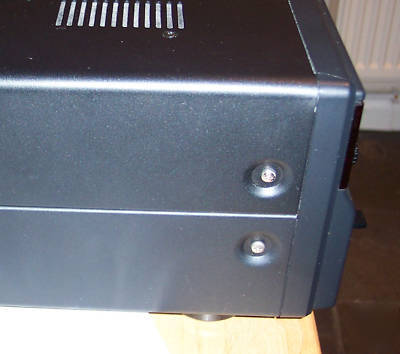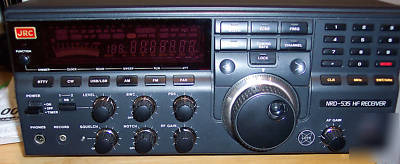Machine Parts For Reuse Newsgroup Discussion Forum > Small Size Parts
> Used
> Mechanical
> Cleveland
> Beautiful jrc nrd-535 with lowe modifications
Beautiful jrc nrd-535 with lowe modifications
Price: NRD-535D: US$1690, CAN$2950, 1995, A$3990. NRD-535: US$1200, 1750, A$3075.
Coverage: 100 kHz - 30 MHz continuous
This review was compiled independently. The Medium Wave Circle and Radio Netherlands has no financial connection with Japan Radio, the manufacturer of this receiver.
The styling of the receiver is a clear improvement over the older NRD-525, and JRC have worked hard to make the set easy to use. There are a lot of controls on the front panel, but you also get a lot of information in the display to tell you what's been activated. It's important to read the instructions before use... you must take off the set's cover to remove the foam strip that prevents damage to the plug-in boards during transit. If you don't there's a good chance the set will overheat! The internal construction of the receiver is excellent, making use of plug in cards for easy maintenance.
The manual tuning knob tunes in 1 Hz, 10 Hz, or 100 Hz steps, depending on how a button is set. The UP-DOWN buttons shift frequencies in 10, 100, or 1000 Hz steps. The digital display can show frequencies to a resolution of 10 Hz.
The NRD-535D is a very sensitive receiver, more so than the NRD-525, but this in fact doesn't mean you'll be able to get any more stations. On HF, at least, once you connect a reasonable antenna, the atmospheric noise reaches such a level that sensitivity much below 1 microvolt means that you're just amplifying the noise as well as the signal. The receiver has a built-in one-step attenuator, but at 20 dB it's somewhat coarse. It would have been nice to have a finer step in between,. i.e. 10 dB. Once again, with the high powers being used in the broadcasting business, the sensitivity figures are just academic.
The NRD-535D is specified to receive signals down as far as 100 kHz, although in fact it will tune lower than that. Below around 30 kHz you'll simply find noise from the receiver's internal synthesizer, but at the test site in The Netherlands strong reception is possible of the time signal station at Mainflingen, near Frankfurt Germany. That's on 77.5 kHz.
The display shows the carrier frequency in AM, SSB and in CW it compensates automatically for an 850 Hz tone. You can adjust the pitch of this tone if you want to through default settings. This compensation also applies to radio teletype.
The attenuator is a relay switched 50-ohm attenuator which unfortunately only has one step (20.6 dB). Use of the attenuator does affect the receiver's intermodulation performance. In addition though, JRC have provided an RF gain control which is continuously variable. The RF gain control does make the set much quieter, but doesn't affect the set's intermodulation performance.
The two AGC positions are fine for general listening, but we found the attack time too slow for fast scanning with computer control. JRC says they are aware of this point and it can be corrected.
The S-meter is strange. Under S5, i.e. 3 microvolts, the "S" meter shows nothing at all. By the time you get to S9, the meter just shows S6. In both our examples, weak signals are always shown weaker than they really are.
The wide filter in the first batch of sets was too wide. It has since been reduced to 5.5 kHz that makes it much better for general broadcast listening and the lock of the synchronous detection is much better on weaker signals. An option of a third filter between the 5.5 and 2.6 kHz filters would be handy for broadcast DX work. In fact JRC has a variable bandwidth option which does the trick, but it's not included in the standard price.
The price of a standard NRD-535 in Europe is around 1750. The price in the US is considerably cheaper, namely US$1200. There are deluxe versions of the receiver with ECSS, variable bandwidth and 1 kHz options fitted as standard.
We conclude that this receiver offers excellent value for the serious shortwave listener. Most of the specifications are excellent, the only slight reservations being in the area of intermodulation and dynamic selectivity. The company has listened to criticism of the NRD-525, and incorporated a lot of extras as standard (e.g. a computer interface).
Lowe Electronics (UK) offer modified versions of the receiver. Using different strategies, issues of AGC, ECSS and audio are addressed.
The NRD-535 is similar to the NRD-535D less the ECSS, VBWC and narrow 1 kHz filter. The price is approximately US $400 less than the NRD-535D.
The NRD-535 won the 1991 World Radio TV Handbook Industry Award for the Best Communications Receiver.



